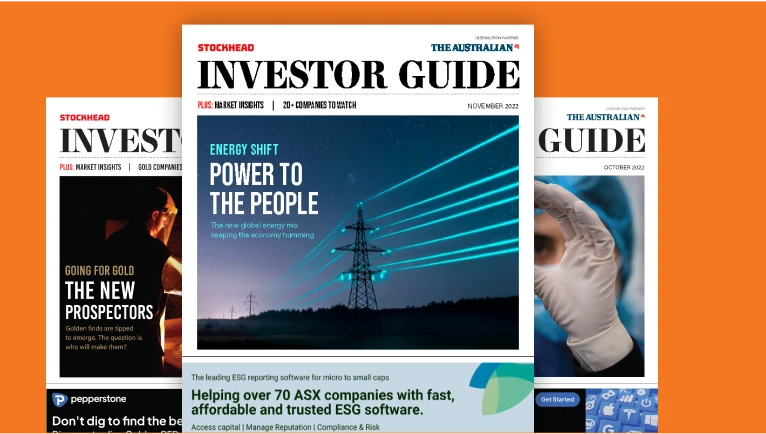Ground Breakers: Will Australia’s $300bn hydrogen pipe dream become reality?

Pic: Yaorusheng/Moment via Getty Images
- Australian export earnings to rise to $459bn in FY23
- Lithium leapfrogs legacy commodities into sixth place, while energy earnings support lower iron ore take
- Hydrogen project pipeline now worth as much as $300bn, but fossil fuel commitments dominate the here and now
We regularly cover the Resources and Energy Quarterly, because it’s important to know Canberra’s actual forecasts on commodity prices and production — not the often comedically conservative numbers pumped into budgets so gov’ts can post surprise budget improvements they churlishly attribute to stellar economic management.
We’re going to see a record $459 billion in export earnings fly into the country as thermal and met coal prices remain stubbornly high, the Department of Industry, Energy, Science and Resources reckon in today’s December update. That’s $9bn up on previous estimates.
Lithium is also poised to capture its largest share of export earnings ever this financial year at $16bn, owing to astonishing spot prices and rising production volumes, leapfrogging aluminium, alumina, copper and crude oil into fifth spot behind iron ore, LNG, met coal, thermal coal and gold.
Australia’s total haul will fall to a still heady $391bn in 2023-24, showing the country continues to be a winner financially from the ongoing mining boom.
But even more interesting this time around is the annual major projects update.
Significantly, the extraordinary volumes of capital being pledged towards hydrogen projects, at a time when doubts still remain about its efficacy as an export.
Hydrogen’s project pipeline, where proponents are seeking to tap into the transition away from fossil fuels, is now the largest of any commodity, rising from an estimated range of $133-185bn in 2021 to $230-303bn in 2022.
Some 32 additional projects have been placed on the drawing board in the past 12 months, tripling the number in Australia’s pipeline.
But the best made plans of mice and men and all that.
There remains a long way to go before these projects are commercial, with two mega projects, the $50bn Asian Renewable Energy Hub and $100bn Western Green Energy Hub in WA, making up half of the proposed projects at various stages of planning.
So far just one hydrogen project was regarded as being at the “completed stage” by the Office of the Chief Economist, with just one at the committed stage.
That means 22 projects, worth up to half the value of the pipeline, are only at the public announced stage, with 24 worth $90.7-146.5bn at the feasibility stage.
Critical minerals led by lithium are grabbing an increasing share of the project pipeline, up from $22-36bn in value in 2021 to $30-42bn in 2022.
But in terms of projects that have actually been committed, fossil fuels and iron ore continue to rule the roost despite the dominance of the ‘energy transition’ narrative in public discourse.
55% of the $83.1bn worth of projects committed to — by value — are in oil and gas ($46bn), with 12.1% in iron ore ($10.3bn) and 9.1% in coal ($7.6bn).
Food, or fuel, for thought.
News from the big dogs
Australia’s biggest gold minerNewcrest (ASX:NCM) has approached the end of an era, saying goodbye to long-term managing director Sandeep Biswas after almost a decade in the role.
The $18.5 billion miner said CFO Sherry Duhe would become interim CEO after Biswas’ retirement.
His time in charge was punctuated by a mini-gold boom and expansion into North America.
“Our company has strong financial fundamentals, a relentless focus on safety and an unrivalled international portfolio of long-life, low-cost gold and copper assets, all of which have been transformed during Sandeep’s tenure,” said chairman Peter Tomsett.
“Today, we are Australia’s largest gold company, the biggest gold producer in British Columbia, and have a substantial presence in Papua New Guinea. We also have a meaningful and increasing exposure to copper – a resource vital to global decarbonisation efforts.”
Over in mining services land the turnaround at Perenti (ASX:PRN), formerly Ausdrill and Barminco, continues with the contractor up 8.1% on news it will increase its EBITA for FY23 from a previously guided $215-230m to $230-250m.
It came off the back of two contract wins, with Perenti securing a variation to expand its scope of work at Regis Resources’ (ASX:RRL) Garden Well gold mine in WA and a new contract for development at Evolution Mining’s (ASX:EVN) Ernest Henry copper-gold mine in Queensland.
Perenti is up more than 24% YTD, with revenue expected to rise from $2.6-2.7bn in 2023 to $2.7-2.9bn.
And Warrego Energy (ASX:WGO) is up 10% after John Poynton-chaired Strike Energy (ASX:STX) waded back into the battle among Perth’s elite for the soul of the gas explorer.
STX, Warrego’s JV partner in the West Erregulla field, says its 33c all-scrip bid is superior to the 28c a share cash bid Gina Rinehart’s Hancock Energy put up to vanquish Kerry Stokes-backed Beach Energy (ASX:BPT) in the battle for WGO’s Perth Basin position.
WGO has told shareholders to take no action as its board weighs up the benefits of each bid.
The energy sector rose 0.6% today while materials was up more than 1% off a broad rally led by the gold miners, with Northern Star (ASX:NST) and Evolution at the head of the pack.
Ground Breakers share prices today:

SUBSCRIBE
Get the latest breaking news and stocks straight to your inbox.
It's free. Unsubscribe whenever you want.
By proceeding, you confirm you understand that we handle personal information in accordance with our Privacy Policy.








